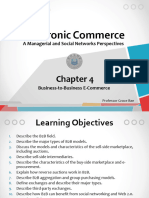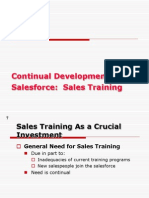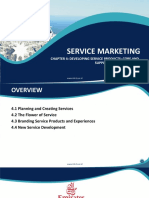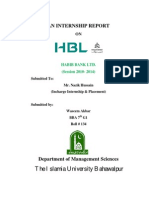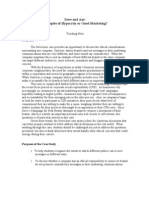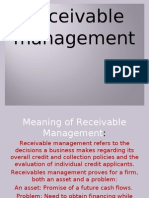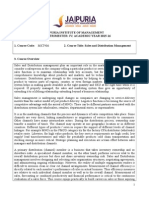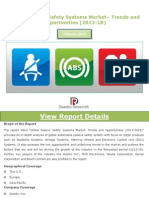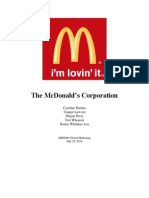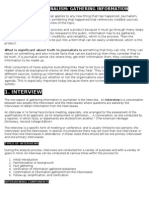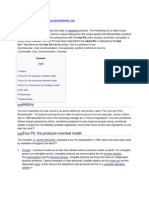E-Commerce : The Revolution
Is Just Beginning
7.1
@ Lalit Sharma, JIM
�What is E-commerce?
Involves digitally enabled commercial
transactions between and among
organizations and individuals
Digitally enabled transactions include all transactions
mediated by digital technology
Commercial transactions involve the exchange of value
across organizational or individual boundaries in return
for products or services
7.2
@ Lalit Sharma, JIM
�E-Commerce
Any form of business transaction in which the parties interact
electronically rather than by physical exchanges or direct
physical contact
E-commerce is usually associated with buying and selling over
the Internet, or conducting any transaction involving the
transfer of ownership or rights to use goods or services through
a computer-mediated network
E-commerce is the use of electronic communications and
digital information processing technology in business
transactions to create, transform, and redefine relationships
for value creation between or among organizations, and
between organizations and individuals
7.3
@ Lalit Sharma, JIM
�E-Commerce Vs E-Business
Many discovered that they did not realize the
distinction between online selling and using the
internet to facilitate trade. The terms e-commerce and
e-business are often misused and interchanged
E-commerce is selling things online, and is
externally focused. Think Amazon.com. E-business
means using the internet and online technologies
to create operating efficiencies, and therefore
increase value to the customer. It is internally
focused. Think swift integration of planning,
sourcing, manufacturing, management, execution,
and selling using IT infrastructure
7.4
@ Lalit Sharma, JIM
�E-Commerce Vs E-Business
The term E-business" was introduced as a deliberate attempt
to say to people: "Your first understanding of E-commerce was
too narrow. To be successful, we need to think more broadly."
E-business goes far beyond E-commerce or buying and selling
over the Internet, and deep into the processes and cultures of
an enterprise. It is the powerful business environment that is
created when you connect critical business systems directly to
customers, employees, vendors, and business partners, using
Intranets, Extranets, ecommerce technologies, collaborative
applications, and the Web.
The transformation of an organizations processes to deliver
additional customer value through the application of
technologies, philosophies and computing paradigm of the
new economy.
7.5
@ Lalit Sharma, JIM
�Why Study E-commerce?
Technology is different and more powerful
than other technologies
Has challenged much traditional business
thinking
Has a number of unique features that help
explain why we have so much interest in ecommerce
7.6
@ Lalit Sharma, JIM
�Unique Features of E-commerce Technology / Why
E-commerce is different
7.7
Ubiquitous
Global reach
Universal standards
Information richness
Interactive
Personalization/customization
Social technology
@ Lalit Sharma, JIM
�Features of E-commerce
Richness and Reach
Richness: depth and detail of information
Reach: how many people a business can connect
with; how many products offered those people
Internet allows much richer communication with
farther reach
7.8
@ Lalit Sharma, JIM
�Customer-Centered Retailing
Direct Sales Over the Web
Disintermediation: Removal of intermediary steps in
a value chain, selling directly to consumers,
significantly lowers purchase transaction costs
7.9
@ Lalit Sharma, JIM
�The benefits of disintermediation to the
consumer
7.10
@ Lalit Sharma, JIM
�Components of EC
To execute these applications, companies need
the right information, infrastructure, and
support services. As shown:
People: Sellers, buyers, intermediaries, information systems specialists
and other employees, and any other participants
Public policy: Legal and other policy and regulating issues, such as
privacy protection and taxation
Marketing and advertising: Like any other business, EC usually
requires the support of marketing and advertising
Support services: Many services are needed to support EC. They range
from payments to order delivery and content creation
Business partnerships: Joint ventures, e-marketplaces, and
partnerships are some frequently occurring relationships in e-business
7.11
@ Lalit Sharma, JIM
�Consumer Drivers
7.12
Convenience
Comparison shopping
Product research before purchase decision
Greater selection
Lower prices
@ Lalit Sharma, JIM
�Critical Role of Trust
Security is a prerequisite but not a substitute for online
trust
Security prevents bad things from happening.
Trust enables good things to happen.
Online trust is an unnatural act
Internet lacks traditional trust markers
Personal acquaintance, geographical proximity, physical
presence are how we once instinctively decided who to trust
7.13
@ Lalit Sharma, JIM
�Digital Trust Hierarchy of Needs
Shared
Value
Relationship
Online Performance
Reputation and Responsiveness
Security and Privacy
Typical B2C Approach
7.14
Consumer Needs
@ Lalit Sharma, JIM
�Management Issues
What are the constraints such as legal issues placed by
the e-environment on developing and implementing an
e-business strategy?
How can trust and privacy be assured for the customer
while seeking to achieve marketing objectives of
customer acquisition and retention?
Assessment of the business relevance of technological
innovation.
7.15
@ Lalit Sharma, JIM
�SLEPT Factors
Macro-environment
Social
Legal
Economic
Political
Technological
7.16
@ Lalit Sharma, JIM
�Building Online Trust
Excellent and consistent performance at the Internet and Web
presence technical and security level
Metrics: Web site speed and reliability; security best practices and
policies
Excellent Web site design and functionality
Metrics: Web site best practices implementation
Business Reputation
Metrics: Perception and value of brand; responsiveness (answer your
e-mail!)
Providing Tangible Value to the Customer along with
Protection of Privacy and Personal Information
Metrics: Privacy policies; valued online services and features
7.17
@ Lalit Sharma, JIM
�Web Features That Build Trust
(From E-Commerce Trust Study by Sapient)
Brand Recognition
Navigational Consistency and Search Function
Reliable Fulfillment
Starting with ease of ordering, clear fulfillment process (explicit
information about what happens once order is placed online, visible and
easy-to-use customer support contacts
Professional Presentation of Content
Accurate, current information and links (no error messages)
Up to Date Technology Especially for Security
Seals of Approval--External Trust Insignia
But only if insignia group is recognized by user
7.18
@ Lalit Sharma, JIM
�What Features Do Consumers Value Most?
Pages load quickly
Conten
t54%
Service
s41%
Commerc
e37%
Site was easy to navigate
52%
50%
48%
Ease of registration/checkout/login
Pages are easy to read/not
28%
44%
42%
35%
37%
27%
confusing
Search function works well
32%
17%
30%
None
16%
22%
22%
Ability to customize site to my
needs
Personalized
8%
11%
4%
8%
7%
14%
offers/recommendations
Source: Jupiter Research/Ipsos-Insight
7.19
@ Lalit Sharma, JIM
�Who Do We Really Trust?
Survey by Ponemon Institute and TRUSTe asked 6,300
consumers to name 5 companies across all industries that they
trusted the most to protect their privacy and the personal
information provided online
Top 5 companies in order of rank
eBay
American Express
Proctor & Gamble (all brands)
Amazon
Hewlett Packard
Also in top 10
US Post Office, IBM, Earthlink, Citibank, Dell
7.20
@ Lalit Sharma, JIM
�What Do We Worry About Most?
The same survey asked respondents what worried them the
most when buying or interacting online (including e-mail, web
browsing and general Internet activities)
Majority worried about:
Identity theft (76%)
SPAM
(58% -- twice as high as in 2003 survey)
Some minority worries
7.21
Legal problems, surveillance, loss of civil liberties
Financial problems, stolen credit card or loss of payment made
Public embarrassment
Stalking or spying activities
@ Lalit Sharma, JIM
�Quantifying the Value of Trust
DoubleClick consumer study
81% of US consumers surveyed send and receive e-mail daily
Consumers consider an e-mail as SPAM when it comes from an un-known
sender (93%) or comes too frequently from a known source (58%)
Despite irritation with SPAM, consumers continue to respond to permissionbased e-mail and offers (which account for less than 8% of total e-mail)
Permission marketing drives sales (and requires trust)
32% of respondents have made made immediate online purchase in response
to e-mail offer
30% have clicked for more info and made online purchase later
12% have clicked for more info and made purchase offline
79% have redeemed e-mailed coupons for online purchases
59% have redeemed e-mailed coupons for offline purchases
7.22
@ Lalit Sharma, JIM
�7.23
@ Lalit Sharma, JIM
�Customization in E-Commerce
7.24
@ Lalit Sharma, JIM
�Types of E-commerce
Classified by nature of market relationship
Business-to-Consumer (B2C)
Business-to-Business (B2B)
Consumer-to-Consumer (C2C)
Classified by type of technology used
Peer-to-Peer (P2P)
Mobile commerce (M-commerce)
7.25
@ Lalit Sharma, JIM
�Categories of Electronic Commerce
Business-to-business (B2B): Both the sellers and the
buyers are business organizations
Collaborative commerce (c-commerce): In ccommerce, business partners collaborate electronically
Business-to-consumers (B2C): The sellers are
organizations, and the buyers are individuals
Consumers-to-businesses (C2B): Consumers make
known a particular need for a product or service, and
suppliers compete to provide it
7.26
@ Lalit Sharma, JIM
�Contd
Consumer-to-consumer (C2C): Individuals sell products or
services to other individuals
Intrabusiness (intraorganizational) commerce: An
organization uses EC internally to improve its operations. A
special case is known as B2E (business to its employees)
Government-to-citizens (G2C): A government provides
services to its citizens via EC technologies
Mobile commerce (m-commerce): When e-commerce is
done in a wireless environment
7.27
@ Lalit Sharma, JIM
�Assessing E-commerce: Successes, Surprises and
Failures
A stunning technological success
Early years have been a mixed success from a
business perspective
Many visions developed during early days of
e-commerce not fulfilled
7.28
@ Lalit Sharma, JIM
�Predictions for the Future
E-commerce technology will continue to propagate through all
commercial activity
E-commerce prices will rise to cover the real cost of doing
business on the Web and pay investors reasonable rate of return
E-commerce margins and profits will rise to levels more typical
of all retailers
In B2C and B2B, traditional Fortune 500 companies will play
growing and dominant role
Number of successful pure online companies will decline and
most successful e-commerce firms will adopt mixed clicks and
bricks strategies
Growth of regulatory activity worldwide
7.29
@ Lalit Sharma, JIM
�Managerial Issues
7.30
Managing resistance to change. Electronic commerce can result in a
fundamental change in how business is done. Resistance to change from
employees, vendors, and customers may develop. Education, training, and
publicity over an extended time period offer possible solutions to the
problem.
Integration of e-commerce into the business environment. E-commerce
needs to be integrated with the rest of the business. Integration issues involve
planning, competition for corporate resources with other projects, and
interfacing EC with databases, existing IT applications, and infrastructure.
Lack of qualified personnel. Very few people have expertise in ecommerce. There are many implementation issues that require expertise, such
as when to offer special promotions on the Internet, how to integrate an emarket with the information systems of buyers and sellers, and what kind of
customer incentives are appropriate under what circumstances.
Privacy. In electronic payment systems, it may be necessary to protect the
identity of buyers. Other privacy issues may involve tracking of Internet user
activities by intelligent agents and cookies, and in-house monitoring of
employees Web activities.
@ Lalit Sharma, JIM
�Managerial Issues (Continued)
Alliances. It is not a bad idea to join an alliance or consortium of
companies to explore e-commerce. Alliances can be created at any
time. Some EC companies (e.g., Amazon.com) have thousands of
alliances. The problem is which alliance to join, or what kind of
alliance to form and with whom.
Choosing the companys strategy toward e-commerce. Generally
speaking there are three major options: (1) Lead: Conduct large-scale
innovative e-commerce activities. (2) Watch and wait: Do nothing, but
carefully watch what is going on in the field in order to determine when
EC is mature enough to enter it. (3) Experiment: Start some ecommerce experimental projects (learn by doing).
Justifying e-commerce by conducting a cost-benefit analysis is very
difficult. Many intangible benefits and lack of experience may produce
grossly inaccurate estimates of costs and benefits. Nevertheless, a
feasibility study must be done, and estimates of costs and benefits must
be made.
7.31
@ Lalit Sharma, JIM
�Chapter 2
E-Commerce Business Models
7.32
@ Lalit Sharma, JIM
�E-commerce Business ModelsDefinitions
Business model
Set of planned activities designed to result in a profit in a
marketplace
Business plan
Describes a firms business model
7.33
@ Lalit Sharma, JIM
�Key Ingredients of a Business Model
7.34
@ Lalit Sharma, JIM
�Value Proposition
Defines how a companys product or service
fulfills the needs of customers
Questions to ask:
Why will customers choose to do business with your firm
instead of another?
What will your firm provide that others do not or cannot?
Examples of successful value propositions:
Personalization/customization
Reduction of product search, price discovery costs
Facilitation of transactions by managing product delivery
7.35
@ Lalit Sharma, JIM
�Revenue Model
Describes how the firm will earn revenue,
generate profits, and produce a superior return
on invested capital
Major types:
7.36
Advertising revenue model
Subscription revenue model
Transaction fee revenue model
Sales revenue model
Affiliate revenue model
@ Lalit Sharma, JIM
�Market Opportunity
Refers to a companys intended
marketspace and the overall potential
financial opportunities available to the firm
in that marketspace
Marketspace: area of actual or potential commercial
value in which company intends to operate
Realistic market opportunity: defined by revenue
potential in each of market niches in which company
hopes to compete
7.37
@ Lalit Sharma, JIM
�Competitive Environment
Refers to the other companies selling similar
products and operating in the same marketspace
Influenced by:
how many competitors are active
how large their operations are
the market share for each competitor
how profitable these firms are
how they price their products
Includes both direct competitors and indirect
competitors
7.38
@ Lalit Sharma, JIM
�Competitive Advantage
Achieved when a firm can produce a
superior product and/or bring product to
market at a lower price than most, or all, of
competitors
Types of competitive advantage include:
First mover advantage
Unfair competitive advantage
7.39
@ Lalit Sharma, JIM
�Market Strategy
Plan that details how a company intends to
enter a new market and attract customers
Best business concepts will fail if not
properly marketed to potential customers
7.40
@ Lalit Sharma, JIM
�Organizational Development
Describes how the company will organize
the work that needs to be accomplished
Work is typically divided into functional
departments
Move from generalists to specialists as
company grows
7.41
@ Lalit Sharma, JIM
�Management Team
Employees of the company responsible for
making the business model work
Strong management team gives instant
credibility to outside investors
Strong management team may not be able to
salvage a weak business model, but should be
able to change the model and redefine the
business as it becomes necessary
7.42
@ Lalit Sharma, JIM
�Categorizing E-commerce Business Models: Some
Difficulties
No one correct way
We categorize business models according to ecommerce sector (B2C, B2B, C2C)
Type of e-commerce technology used can also
affect classification of a business model
Some companies use multiple business models
7.43
@ Lalit Sharma, JIM
�B2C Business Models: Portal
Offers powerful search tools plus an
integrated package of content and services
Typically utilizes a combined
subscription/advertising
revenues/transaction fee model
May be general or specialized
7.44
@ Lalit Sharma, JIM
�B2C Business Models: E-tailer
Online version of traditional retailer
Types include:
7.45
Virtual merchants
Bricks-and-clicks
Catalog merchants
Manufacturer-direct
@ Lalit Sharma, JIM
�B2C Business Models: Content Provider
Information and entertainment companies that
provide digital content over the Web
Typically utilizes a subscription, pay for
download, or advertising revenue model
Syndication a variation of standard content
provider model
7.46
@ Lalit Sharma, JIM
�B2C Business Models: Transaction Broker
Processes online transactions for consumers
Primary value propositionsaving time and
money
Typical revenue modeltransaction fee
Industries using this model include:
Financial services
Travel services
Job placement services
7.47
@ Lalit Sharma, JIM
�B2C Business Models: Market Creator
Uses Internet technology to create markets that
bring buyers and sellers together
Examples:
Priceline.com
eBay.com
Typically uses a transaction fee revenue model
7.48
@ Lalit Sharma, JIM
�B2C Business Models: Service Provider
Offers services online
Value proposition: valuable, convenient, timesaving, low-cost alternatives to traditional
service providers
Revenue models: subscription fees or one-time
payment
7.49
@ Lalit Sharma, JIM
�B2C Business Models: Community Provider
Sites that create a digital online environment
where people with similar interests can
transact, communicate, and receive interestrelated information.
Typically rely on a hybrid revenue model
Examples:
iVillage
Friendster
About.com
7.50
@ Lalit Sharma, JIM
�Insight on Technology: Search, Ads, and Apps: The
Future For Google (and Microsoft)
Class Discussion
How many of you use Google, Yahoo, or
MSN search engines? Does the class differ
from the overall Web population?
Why do you use a particular search engine?
Why are search engines so profitable?
Why do people stay longer at Yahoo and
MSN.com when compared to Google? Does
this give them an advantage?
7.51
@ Lalit Sharma, JIM
�B2B Business Models: E-distributor
Supplies products and services directly to
individual businesses
Owned by one company seeking to serve
many customers
Example: Grainger.com
7.52
@ Lalit Sharma, JIM
�B2B Business Models: E-procurement
Creates and sells access to digital electronic
markets
B2B service provider is one type
Application service providers: a subset of B2B
service providers
Example:Ariba
7.53
@ Lalit Sharma, JIM
�B2B Business Models: Exchanges
Electronic digital marketplace where
suppliers and commercial purchasers can
conduct transactions
Usually owned by independent firms whose
business is making a market
Generate revenue by charging transaction fees
Usually serve a single vertical industry
Number of exchanges has fallen dramatically
7.54
@ Lalit Sharma, JIM
7.55
Insight on Business: Onvia Evolves
Class Discussion
Why did Onvia have a difficult time with its
early business model?
What type of B2B business model is Onvia
using now? Is it still an exchange?
Why is the government market succeeding?
What services does Onvia provide to
government buyers? To small business
sellers?
How does Onvia make money?
@ Lalit Sharma, JIM
�B2B Business Models: Industry Consortia
Industry-owned vertical marketplaces that
serve specific industries
Horizontal marketplaces, in contrast, sell
specific products and services to a wide range
of industries
Example: Exostar
7.56
@ Lalit Sharma, JIM
�B2B Business Models: Private Industrial
Networks
Digital networks designed to coordinate the
flow of communications among firms engaged
in business together
Single firm network: the most common form
(Example: Wal-Mart)
Industry-wide networks: often evolve out of
industry associations (Example: Agentrics)
7.57
@ Lalit Sharma, JIM
�Business Models in Emerging E-commerce Areas
Consumer-to-Consumer (C2C): Provides a way
for consumers to sell to each other, with the
help of an online marketmaker
Peer-to-Peer (P2P): Links users, enabling them
to share files and common resources without a
common server
M-commerce: E-commerce business models
that use wireless technologies
To date, m-commerce a disappointment in the United States;
however, technology platform continues to evolve
7.58
@ Lalit Sharma, JIM
�Insight on Society: Is Privacy Possible in a
Wireless World?
Class Discussion
Why should you care if companies and government
agencies track your cell phone? What is the threat if you
are not doing anything wrong?
What is the opt-in principle and how does it protect
privacy?
Should business firms be allowed to call cell phones with
advertising messages based on location?
Should customer location information be protected from
government agencies?
7.59
@ Lalit Sharma, JIM
�E-commerce Enablers: The Gold Rush Model
Internet infrastructure companies
Provide hardware, software, networking, security, ecommerce software systems, payment systems, databases,
hosting services, etc.
7.60
@ Lalit Sharma, JIM
�How the Internet and the Web Change Business:
Strategy, Structure, and Process
E-commerce changes the nature of players
in an industry and their relative bargaining
power by changing:
7.61
the basis of competition among rivals
the barriers to entry
the threat of new substitute products
the strength of suppliers
the bargaining power of buyers
@ Lalit Sharma, JIM
�Industry Value Chains
Set of activities performed in an industry by
suppliers, manufacturers, transporters,
distributors, and retailers that transform raw
inputs into final products and services
Reduces the cost of information and other
transactional costs
7.62
@ Lalit Sharma, JIM
�E-commerce and Industry Value Chains
7.63
@ Lalit Sharma, JIM
�Firm Value Chains
Set of activities that a firm engages in to create
final products from raw inputs
Increases operational efficiency
7.64
@ Lalit Sharma, JIM
�E-commerce and Firm Value Chains
7.65
@ Lalit Sharma, JIM
�Firm Value Webs
Networked business ecosystem that uses
Internet technology to coordinate the value
chains of business partners within an industry,
or within a group of firms
Coordinates a firms suppliers with its own
production needs using an Internet-based
supply chain management system
7.66
@ Lalit Sharma, JIM
�Internet-Enabled Value Web
7.67
@ Lalit Sharma, JIM
�Business Strategy
Set of plans for achieving superior long-term
returns on the capital invested in a business
firm (i.e., a plan for making a profit in a
competitive environment)
Four generic strategies
7.68
Differentiation
Cost
Scope
Focus
@ Lalit Sharma, JIM

